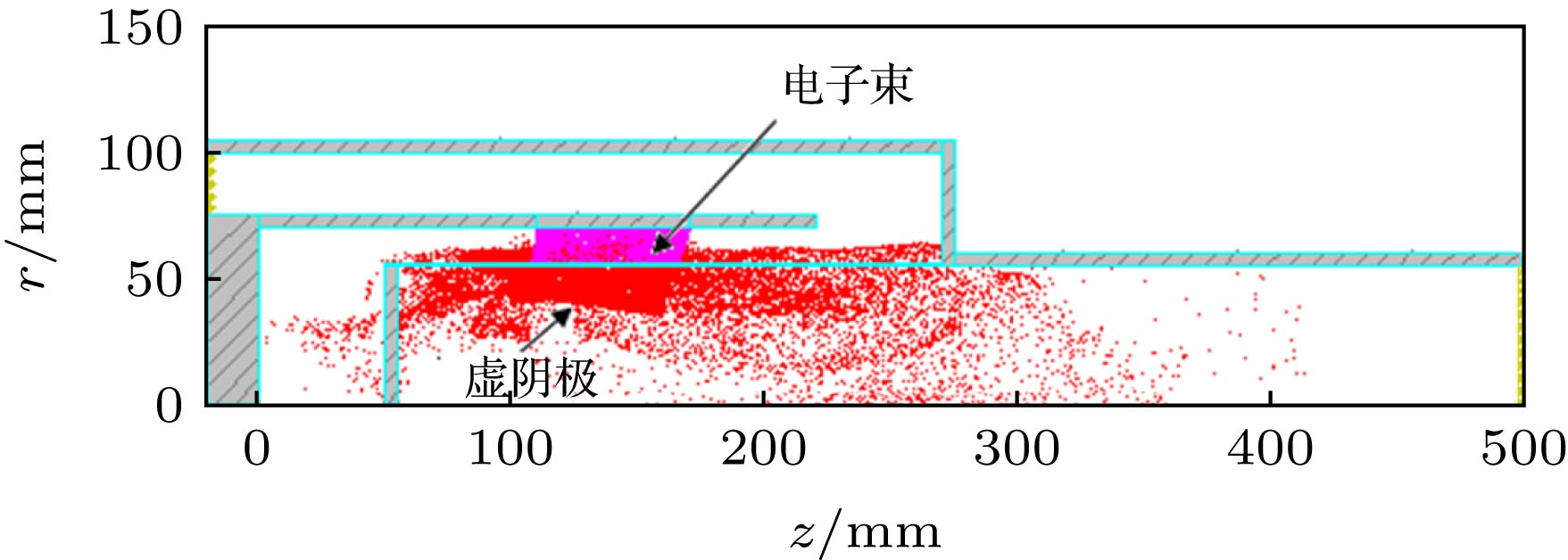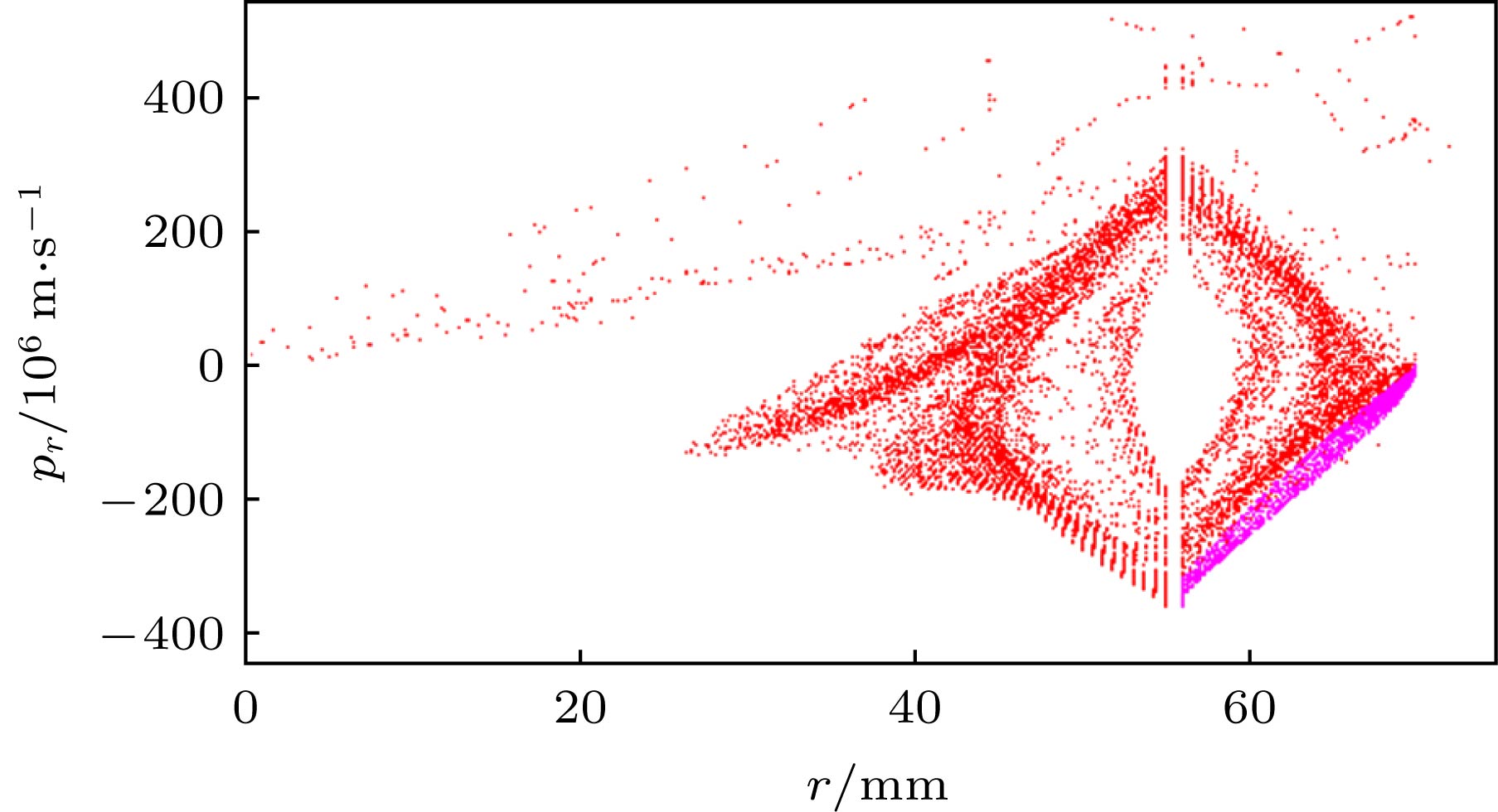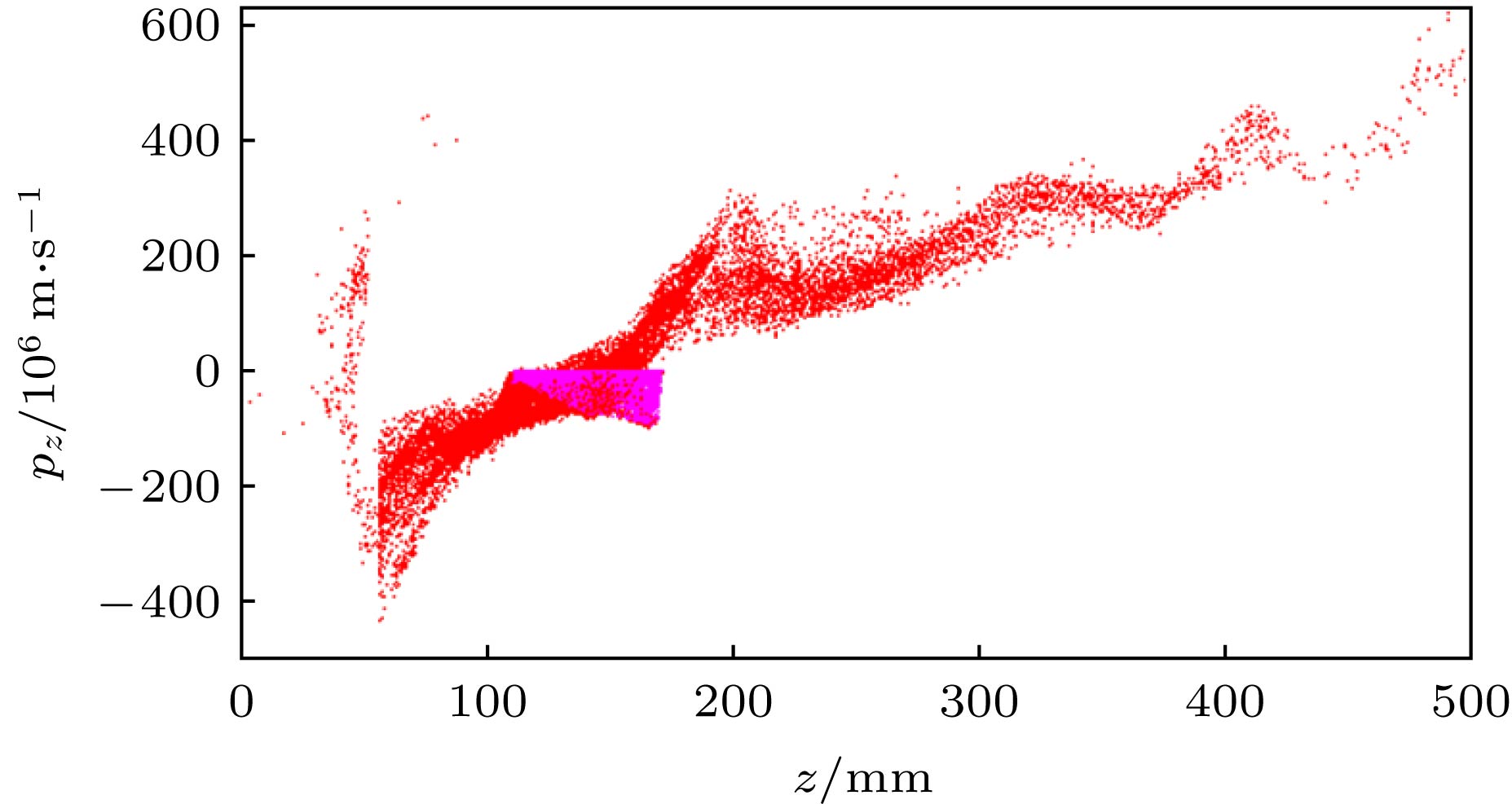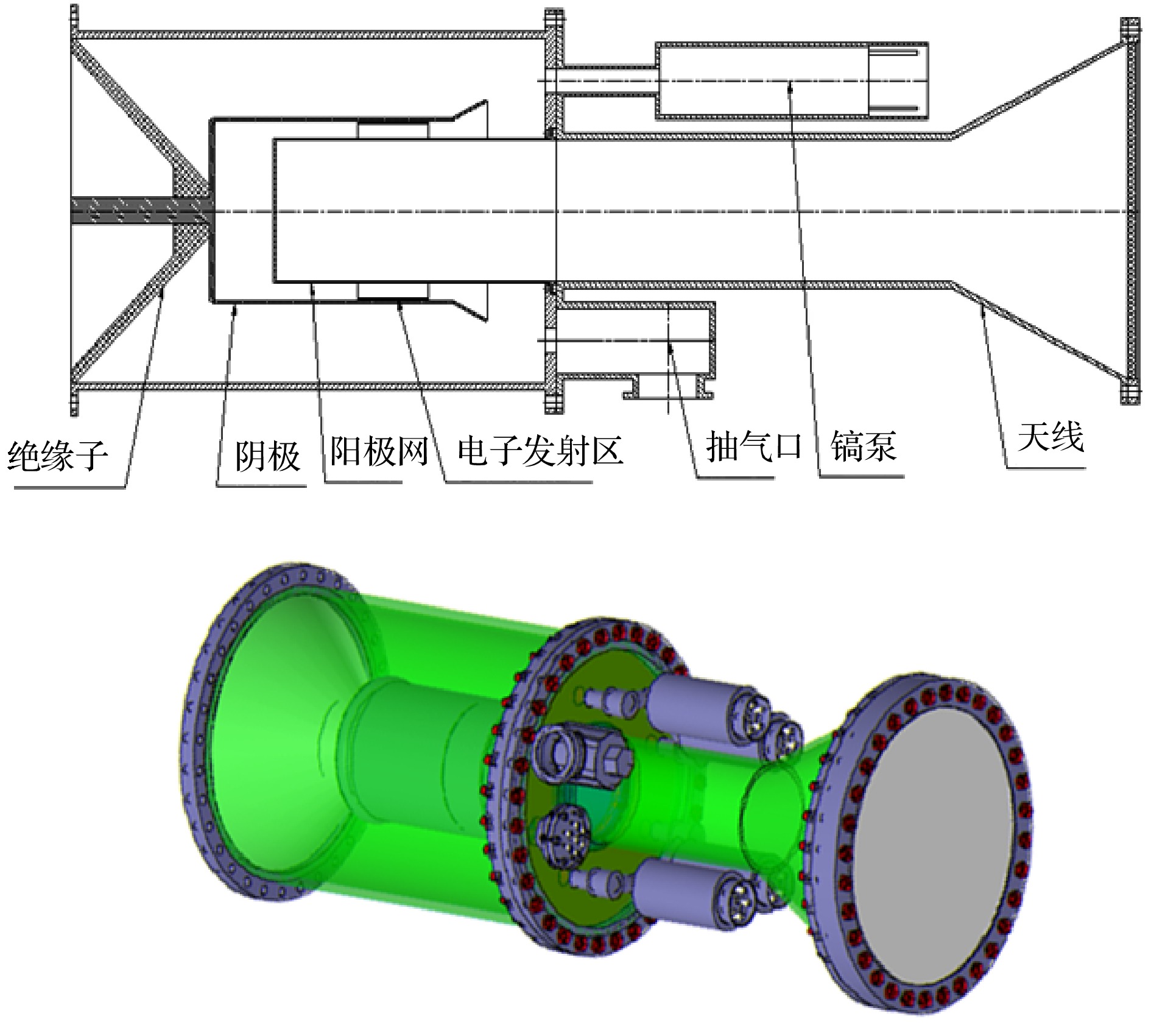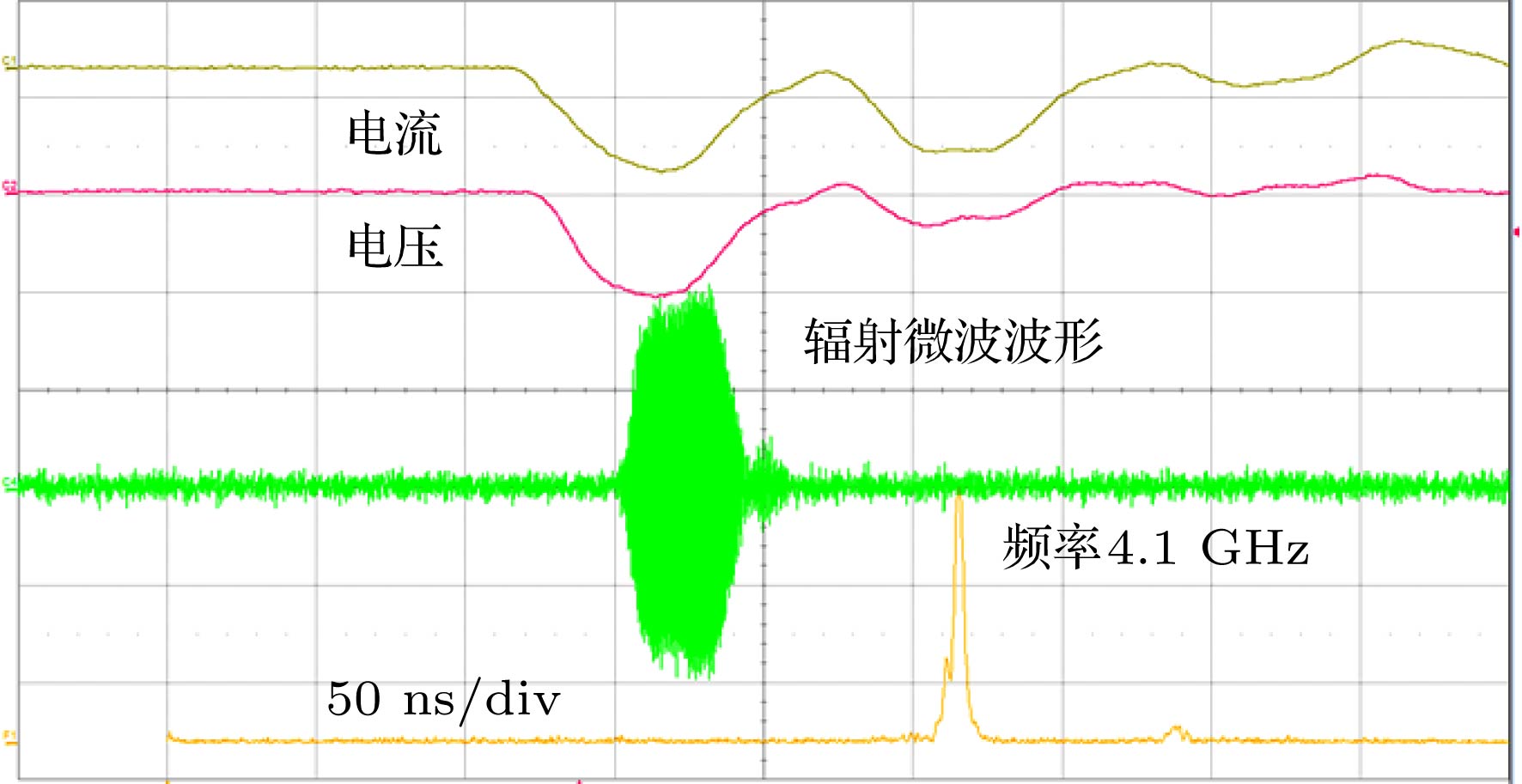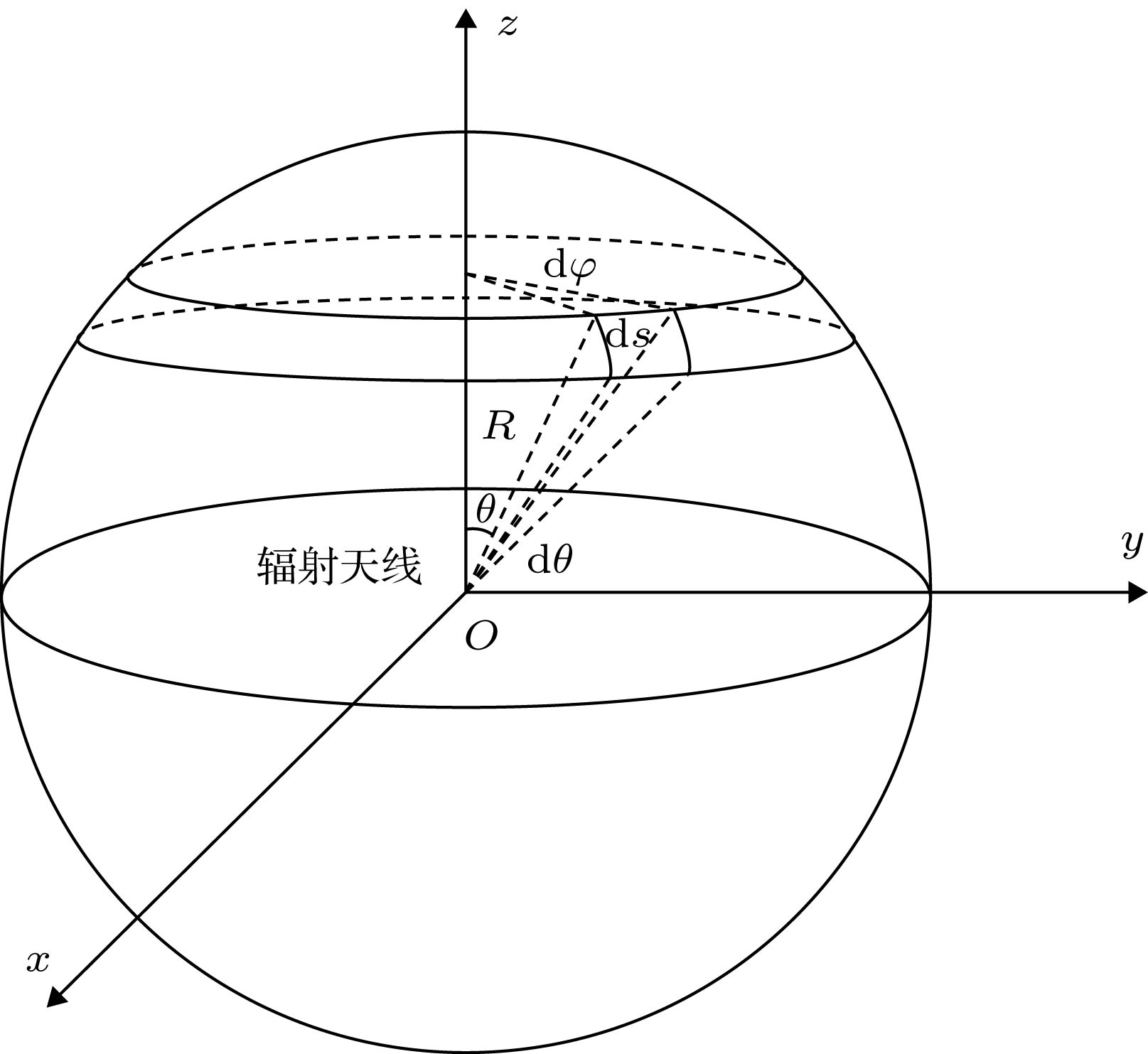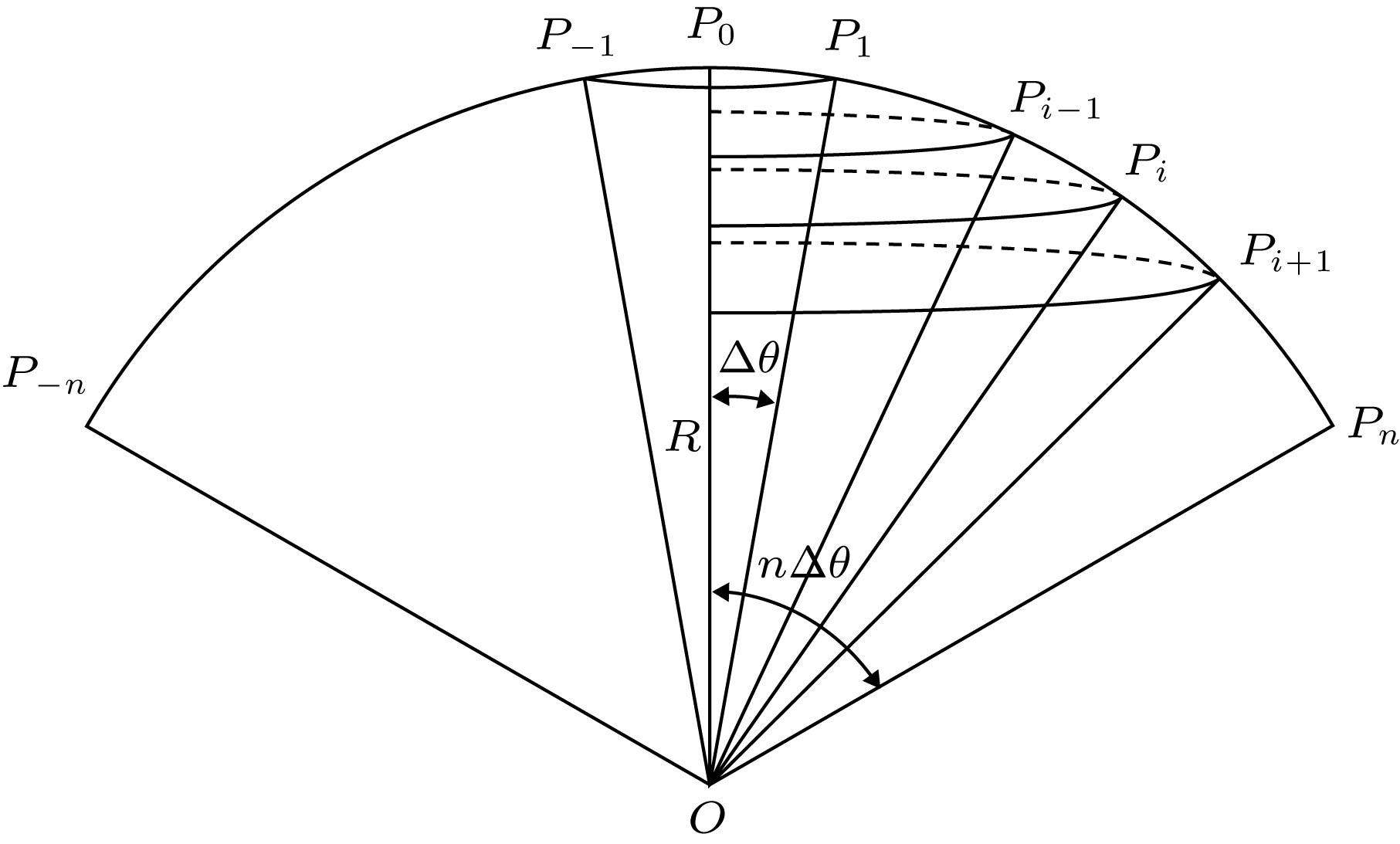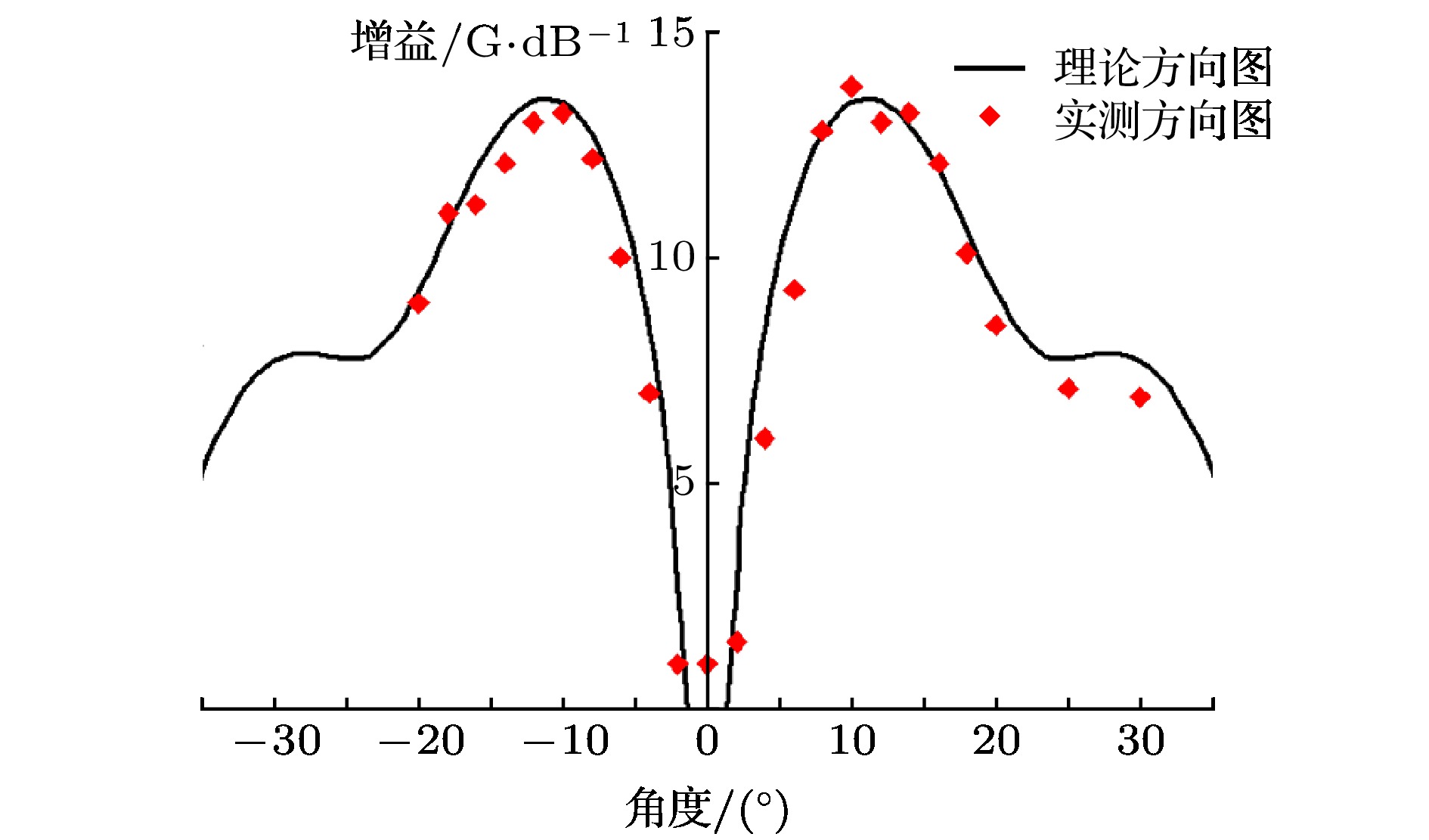-
Virtual cathode oscillator, as a kind of space-charge high-power microwave source, has an output microwave mode that is generally an admixture of TM01 mode and TE11 mode. The analysis of the resonator in the anode mesh shows that when the transmission of the anode mesh is high, it is easy to produce strong reflected electron beam, forming a conical quasi-resonator structure, thus enhances the output of TE11 mode. When the transmission of the anode mesh is low, the beam intensity of the reflected electron beam can be weakened due to the absorption of the metal mesh, and the TE11 mode can be suppressed, so the output mode is mainly TM01 mode. In this paper, a feedback coaxial virtual cathode oscillator is investigated with the use of numerical simulation and experimental data analysis. The feedback coaxial virtual cathode oscillator is formed by closing the end of the anode mesh through a metal plate and changing the path of the reflected electron beam from the metal mesh to the gap between cathode and anode. The particle in cell method is used in the numerical simulation of the virtual cathode oscillator, and the impedance of the 400 kV diode is about 13 Ω under a voltage of 400 kV. After the optimal design by numerical simulation, the average output microwave power from the virtual cathode oscillator is 1.5 GW, and the frequency of the microwave is about 4.2 GHz, which is basically consistent with the theoretical calculation results. In this new kind of virtual cathode oscillator, the distribution of reflected electrons is modified by the feedback sheet on the anode mesh, the output high power microwave pattern is demonstrated to be dominated by TM01 mode. The microwave power obtained in the experiment is measured by the array antenna power density integration method. For axisymmetric mode, a receiving antenna array is formed by placing multiple receiving antennas on one side of the axis of the antenna pattern. The power densities of different angles on the horizontal circumference with the phase center of the transmitting antenna are measured, the average power density of two adjacent points is multiplied by the area of the spherical belt between these two points, and then the resulting power is added by the power between the adjacent two points, thereby obtaining the total radiation power. With this method, the microwave power is 850 MW with frequency 4.1 GHz and pulse width 30 ns under slaving voltage 400 kV.
[1] Benford J, Swgle J 1992 High Power Microwaves (New York: Artech House Inc.) pp1–3
[2] Jiang W H, Woolverton K, Dickens J 1999 IEEE Trans. Plasma Sci. 27 1538
 Google Scholar
Google Scholar
[3] Chen X P, Dickens J, Choi E H 2003 Proc of the 2003 IEEE Inter Pulse Power Conf Dallas, TX, USA, June 15–18, 2003 p1165
[4] 罗雄, 廖成, 孟凡宝 2006 物理学报 55 5774
 Google Scholar
Google Scholar
Luo X, Liao C, Meng F B 2006 Acta Phys. Sin. 55 5774
 Google Scholar
Google Scholar
[5] Evgney G, Pavel M 2015 IEEE Trans. Plasma Sci. 43 1014
 Google Scholar
Google Scholar
[6] Yang Z F, Liu G Z, Shao H, Sun J, Zhang Y C, Ye H, Yang M 2013 IEEE Trans. Plasma Sci. 41 3604
 Google Scholar
Google Scholar
[7] Fan Y W, Li Z Q, Sh T, Liu J 2014 Chin. Phys. B 23 075208
 Google Scholar
Google Scholar
[8] Champeaux S, Gouard P, Cousin R, Larour J 2016 IEEE Trans. Plasma Sci. 44 31
 Google Scholar
Google Scholar
[9] Kitsanov S A, Klimov A I, Korovin S D, Kurkan I K, Pegel I V, Polevin S D 2002 IEEE Trans. Plasma Sci. 30 274
 Google Scholar
Google Scholar
[10] Song K B, Lim J E, Seo Y, Choi E H 2009 IEEE Trans. Plasma Sci. 37 304
 Google Scholar
Google Scholar
[11] Jiang W H, Magne K 2001 Phys. Plasmas 8 3781
 Google Scholar
Google Scholar
[12] Jennie A, Mats J, Denny A 2013 IEEE Trans. Plasma Sci. 41 2758
 Google Scholar
Google Scholar
[13] 叶卫民, 李传胪 1998 强激光与粒子束 10 268
Ye W M, Li C L 1998 High Power Laser and Particle Beams 10 268
[14] Shao H, Liu G Z, Yang Z F 2005 J. Plasma Phys. 71 563
 Google Scholar
Google Scholar
[15] 劭浩, 刘国治, 杨占峰 2006 强激光与粒子束 18 230
Shao H, Liu G Z, Yang Z F 2006 High Power Laser and Particle Beams 18 230
[16] 邵浩, 刘国治 2001 物理学报 50 2387
 Google Scholar
Google Scholar
Shao H, Liu G Z 2001 Acta Phys. Sin. 50 2387
 Google Scholar
Google Scholar
[17] 刘静, 舒挺, 李志强 2011 物理学报 60 105202
 Google Scholar
Google Scholar
Liu J, Shu T, Li Z Q 2011 Acta Phys. Sin. 60 105202
 Google Scholar
Google Scholar
[18] 张永鹏, 刘国治, 邵浩, 杨占峰, 宋志敏, 林郁正 2009 物理学报 58 6973
 Google Scholar
Google Scholar
Zhang Y P, Liu G Z, Shao H, Yang Z F, Song Z M, Lin Y Z 2009 Acta Phys. Sin. 58 6973
 Google Scholar
Google Scholar
[19] 张运俭, 孟凡宝, 范植开 2007 强激光与粒子束 19 682
Zhang Y J, Meng F B, Fan Z K 2007 High Power Laser and Particle Beams 19 682
[20] Woo W 1987 Phys. Fluids 30 239
 Google Scholar
Google Scholar
[21] Xing Q Z, Wang D, Huang F, Deng J K 2006 IEEE Trans. Plasma Sci. 34 584
 Google Scholar
Google Scholar
-
-
[1] Benford J, Swgle J 1992 High Power Microwaves (New York: Artech House Inc.) pp1–3
[2] Jiang W H, Woolverton K, Dickens J 1999 IEEE Trans. Plasma Sci. 27 1538
 Google Scholar
Google Scholar
[3] Chen X P, Dickens J, Choi E H 2003 Proc of the 2003 IEEE Inter Pulse Power Conf Dallas, TX, USA, June 15–18, 2003 p1165
[4] 罗雄, 廖成, 孟凡宝 2006 物理学报 55 5774
 Google Scholar
Google Scholar
Luo X, Liao C, Meng F B 2006 Acta Phys. Sin. 55 5774
 Google Scholar
Google Scholar
[5] Evgney G, Pavel M 2015 IEEE Trans. Plasma Sci. 43 1014
 Google Scholar
Google Scholar
[6] Yang Z F, Liu G Z, Shao H, Sun J, Zhang Y C, Ye H, Yang M 2013 IEEE Trans. Plasma Sci. 41 3604
 Google Scholar
Google Scholar
[7] Fan Y W, Li Z Q, Sh T, Liu J 2014 Chin. Phys. B 23 075208
 Google Scholar
Google Scholar
[8] Champeaux S, Gouard P, Cousin R, Larour J 2016 IEEE Trans. Plasma Sci. 44 31
 Google Scholar
Google Scholar
[9] Kitsanov S A, Klimov A I, Korovin S D, Kurkan I K, Pegel I V, Polevin S D 2002 IEEE Trans. Plasma Sci. 30 274
 Google Scholar
Google Scholar
[10] Song K B, Lim J E, Seo Y, Choi E H 2009 IEEE Trans. Plasma Sci. 37 304
 Google Scholar
Google Scholar
[11] Jiang W H, Magne K 2001 Phys. Plasmas 8 3781
 Google Scholar
Google Scholar
[12] Jennie A, Mats J, Denny A 2013 IEEE Trans. Plasma Sci. 41 2758
 Google Scholar
Google Scholar
[13] 叶卫民, 李传胪 1998 强激光与粒子束 10 268
Ye W M, Li C L 1998 High Power Laser and Particle Beams 10 268
[14] Shao H, Liu G Z, Yang Z F 2005 J. Plasma Phys. 71 563
 Google Scholar
Google Scholar
[15] 劭浩, 刘国治, 杨占峰 2006 强激光与粒子束 18 230
Shao H, Liu G Z, Yang Z F 2006 High Power Laser and Particle Beams 18 230
[16] 邵浩, 刘国治 2001 物理学报 50 2387
 Google Scholar
Google Scholar
Shao H, Liu G Z 2001 Acta Phys. Sin. 50 2387
 Google Scholar
Google Scholar
[17] 刘静, 舒挺, 李志强 2011 物理学报 60 105202
 Google Scholar
Google Scholar
Liu J, Shu T, Li Z Q 2011 Acta Phys. Sin. 60 105202
 Google Scholar
Google Scholar
[18] 张永鹏, 刘国治, 邵浩, 杨占峰, 宋志敏, 林郁正 2009 物理学报 58 6973
 Google Scholar
Google Scholar
Zhang Y P, Liu G Z, Shao H, Yang Z F, Song Z M, Lin Y Z 2009 Acta Phys. Sin. 58 6973
 Google Scholar
Google Scholar
[19] 张运俭, 孟凡宝, 范植开 2007 强激光与粒子束 19 682
Zhang Y J, Meng F B, Fan Z K 2007 High Power Laser and Particle Beams 19 682
[20] Woo W 1987 Phys. Fluids 30 239
 Google Scholar
Google Scholar
[21] Xing Q Z, Wang D, Huang F, Deng J K 2006 IEEE Trans. Plasma Sci. 34 584
 Google Scholar
Google Scholar
计量
- 文章访问数: 12529
- PDF下载量: 71
- 被引次数: 0













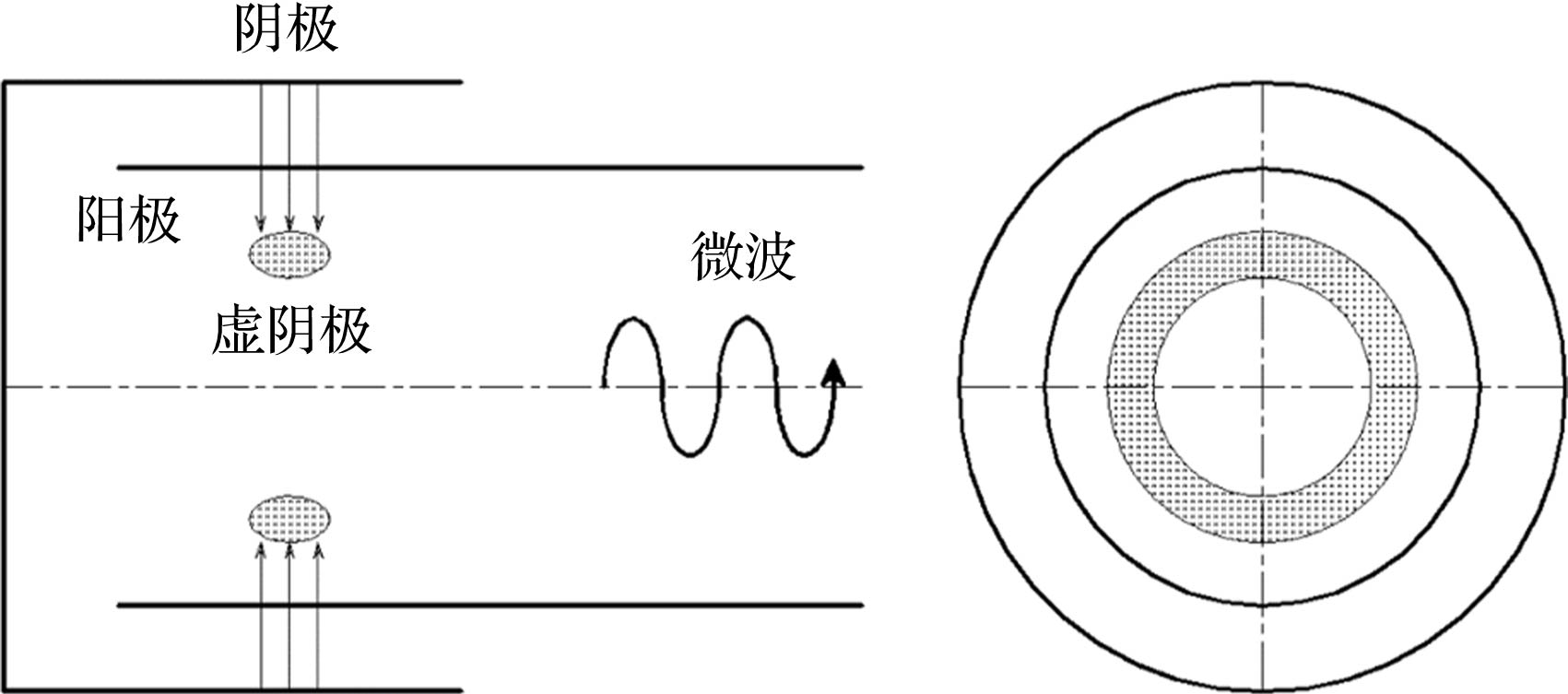
 下载:
下载:


